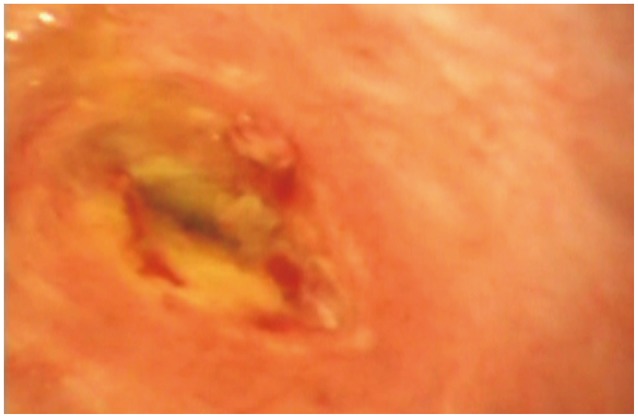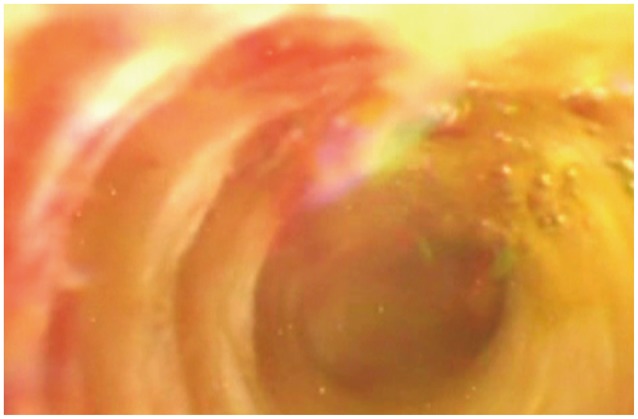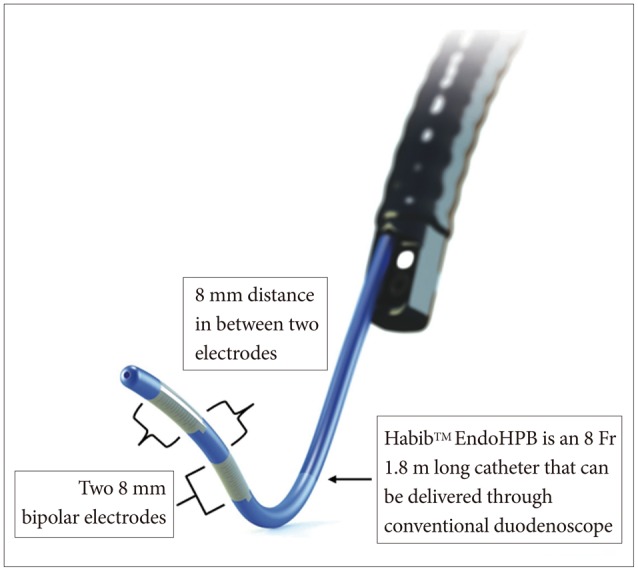Clin Endosc.
2015 Jan;48(1):15-19. 10.5946/ce.2015.48.1.15.
Endoscopic Ablation Therapy for Biliopancreatic Malignancies
- Affiliations
-
- 1Division of Gastroenterology and Hepatology and Combined GI Endoscopy Unit, Department of Medicine, University of Malaya Medical Center, Kuala Lumpur, Malaysia. klgoh56@gmail.com
- 2Manila Doctor's Hospital, Manila, Philippines.
- 3Asian Institute of Gastroenterology, Hyderabad, India.
- KMID: 2221753
- DOI: http://doi.org/10.5946/ce.2015.48.1.15
Abstract
- Biliopancreatic malignancies such as cholangiocarcinoma (CCA) has notoriously been diagnosed late. As such most therapy have been palliative in nature. Cholangioscopy allows for an earlier diagnosis to be made. Brachytherapy with the insertion of catheter with iridium-132 seeds, percutaneously or through endoscopic retrograde cholangiopancreatography (ERCP) was the earliest ablative techniques used. It has been shown to have a beneficial effect only in prolonging survival. Photodynamic therapy (PDT) has also been used for several years. stenting with PDT versus stenting alone for unresectable CCA showed a marked survival benefit with the addition of PDT. However the most exciting endoscopic ablative modality appears to be intraductal radiofrequency ablation using the Habib catheter and device. Several case series have shown the effectiveness of this technique in ablating tumors. This technique is evolving and coupled with early diagnosis of CCA through cholangioscopy will allow for a curative therapy. The crux to the effective treatment of early cancerous lesions in the bile or pancreatic duct is the early diagnosis of such lesions. Effective endoscopic ablative therapy is now available with the advent of radiofrequency ablation probes that can be passed through the duodenoscope via ERCP.
MeSH Terms
Figure
Cited by 1 articles
-
Survival Benefit of Intraductal Radiofrequency Ablation for Malignant Biliary Obstruction: A Systematic Review with Meta-Analysis
Byung Hyo Cha, Myoung-Jin Jang, Sang Hyub Lee
Clin Endosc. 2021;54(1):100-106. doi: 10.5946/ce.2020.254.
Reference
-
1. American Society for Gastrointestinal Endoscopy (ASGE) Standards of Practice Committee. Anderson MA, Appalaneni V, et al. The role of endoscopy in the evaluation and treatment of patients with biliary neoplasia. Gastrointest Endosc. 2013; 77:167–174. PMID: 23219047.
Article2. Rerknimitr R, Angsuwatcharakon P, Ratanachu-ek T, et al. Asia-Pacific consensus recommendations for endoscopic and interventional management of hilar cholangiocarcinoma. J Gastroenterol Hepatol. 2013; 28:593–607. PMID: 23350673.
Article3. Rizvi S, Gores GJ. Pathogenesis, diagnosis, and management of cholangiocarcinoma. Gastroenterology. 2013; 145:1215–1229. PMID: 24140396.
Article4. Mihalache F, Tantau M, Diaconu B, Acalovschi M. Survival and quality of life of cholangiocarcinoma patients: a prospective study over a 4 year period. J Gastrointestin Liver Dis. 2010; 19:285–290. PMID: 20922193.5. Chahal P, Baron TH. Endoscopic palliation of cholangiocarcinoma. Curr Opin Gastroenterol. 2006; 22:551–560. PMID: 16891889.
Article6. Montemaggi P, Costamagna G, Dobelbower RR, et al. Intraluminal brachytherapy in the treatment of pancreas and bile duct carcinoma. Int J Radiat Oncol Biol Phys. 1995; 32:437–443. PMID: 7538501.
Article7. Deodato F, Clemente G, Mattiucci GC, et al. Chemoradiation and brachytherapy in biliary tract carcinoma: long-term results. Int J Radiat Oncol Biol Phys. 2006; 64:483–488. PMID: 16242254.
Article8. Takamura A, Saito H, Kamada T, et al. Intraluminal low-dose-rate 192Ir brachytherapy combined with external beam radiotherapy and biliary stenting for unresectable extrahepatic bile duct carcinoma. Int J Radiat Oncol Biol Phys. 2003; 57:1357–1365. PMID: 14630274.
Article9. Shin HS, Seong J, Kim WC, et al. Combination of external beam irradiation and high-dose-rate intraluminal brachytherapy for inoperable carcinoma of the extrahepatic bile ducts. Int J Radiat Oncol Biol Phys. 2003; 57:105–112. PMID: 12909222.
Article10. Charbel H, Al-Kawas FH. Cholangiocarcinoma treatment. Curr Gastroenterol Rep. 2012; 14:528–533. PMID: 22968375.
Article11. Ortner ME, Caca K, Berr F, et al. Successful photodynamic therapy for nonresectable cholangiocarcinoma: a randomized prospective study. Gastroenterology. 2003; 125:1355–1363. PMID: 14598251.
Article12. Cheon YK, Lee TY, Lee SM, Yoon JY, Shim CS. Longterm outcome of photodynamic therapy compared with biliary stenting alone in patients with advanced hilar cholangiocarcinoma. HPB (Oxford). 2012; 14:185–193. PMID: 22321037.
Article13. Leggett CL, Gorospe EC, Murad MH, Montori VM, Baron TH, Wang KK. Photodynamic therapy for unresectable cholangiocarcinoma: a comparative effectiveness systematic review and meta-analyses. Photodiagnosis Photodyn Ther. 2012; 9:189–195. PMID: 22959798.
Article14. Dolak W, Schreiber F, Schwaighofer H, et al. Endoscopic radiofrequency ablation for malignant biliary obstruction: a nationwide retrospective study of 84 consecutive applications. Surg Endosc. 2014; 28:854–860. PMID: 24196547.
Article15. Steel AW, Postgate AJ, Khorsandi S, et al. Endoscopically applied radiofrequency ablation appears to be safe in the treatment of malignant biliary obstruction. Gastrointest Endosc. 2011; 73:149–153. PMID: 21184881.
Article16. Tatli S, Tapan U, Morrison PR, Silverman SG. Radiofrequency ablation: technique and clinical applications. Diagn Interv Radiol. 2012; 18:508–516. PMID: 22407695.
Article17. EMcision. Habib EndoHPB catheter [Internet]. Montreal: EMcision;2014. cited 2015 Jan 12. Available from: http://emcision.com/products/habib-endohpb1/.18. Monga A, Gupta R, Ramchandani M, Rao GV, Santosh D, Reddy DN. Endoscopic radiofrequency ablation of cholangiocarcinoma: new palliative treatment modality (with videos). Gastrointest Endosc. 2011; 74:935–937. PMID: 21168839.
Article19. Alis H, Sengoz C, Gonenc M, Kalayci MU, Kocatas A. Endobiliary radiofrequency ablation for malignant biliary obstruction. Hepatobiliary Pancreat Dis Int. 2013; 12:423–427. PMID: 23924501.
Article20. Figueroa-Barojas P, Bakhru MR, Habib NA, et al. Safety and efficacy of radiofrequency ablation in the management of unresectable bile duct and pancreatic cancer: a novel palliation technique. J Oncol. 2013; 2013:910897. PMID: 23690775.
Article
- Full Text Links
- Actions
-
Cited
- CITED
-
- Close
- Share
- Similar articles
-
- Endoscopic Palliation for Biliary and Pancreatic Malignancies: Recent Advances
- Role of radiofrequency ablation in advanced malignant hilar biliary obstruction
- Recent Update of Endoscopic Radiofrequency Ablation for Pancreatobiliary Disease
- Recent Updates on Endoscopic Retrograde Cholangiography-guided Intraductal Radiofrequency Ablation for Malignant Biliary Stricture
- Recent developments in endoscopic ultrasound-guided ablation treatment




